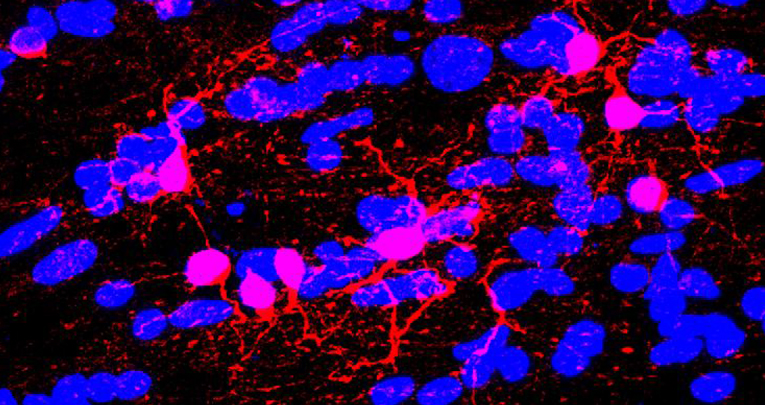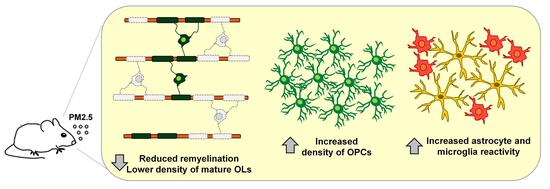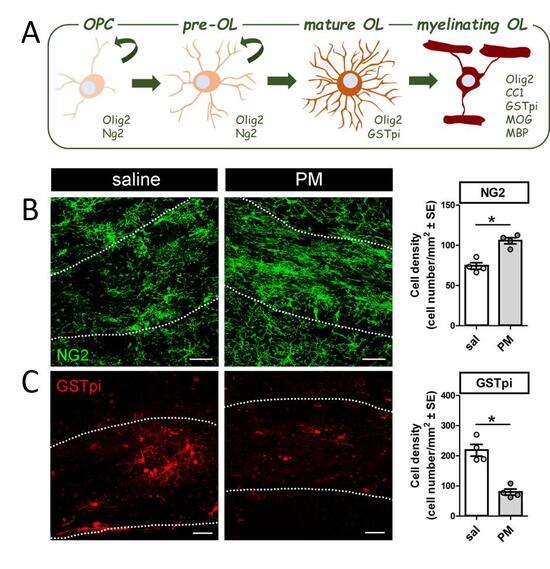
Neurochemistry International, May 2021
Exposure to fine particulate matter (PM2.5) hampers myelin repair in a mouse model of white matter demyelination
Roberta Parolisi a,b , Francesca Montarolo b,c,d , Alessandro Pini e , Sabrina Rovelli f , Andrea Cattaneo f , Antonio Bertolotto b,c , Annalisa Buffo a,b , Valentina Bollati g , Enrica Boda a,b
Multiple Sclerosis is a chronic autoimmune disease in which immune system elements invade the central nervous system and target myelin ensheating neuronal axons, compromising the transmission of information among neurons. Myelin injury is accompanied by the activation of astrocytes and microglia, which physiologically extertneurosupportive functions, but, when activated by the immune system as in Multiple Sclerosis, contribute to neuroinfiammation. In the early stages of the disease, myelin can still be repaired by glial cells present in the nervous tissue, called oligodendrocytes, and this contributes to the remission – unfortunately often only temporary – of symptoms.
Epidemiological studies have shown an association between exposure to air pollution, and in particular to airborne particulate matter – the famous PM– the prevalence of Multiple Sclerosis in some populations and the frequency of hospital access due to the onset or recurrence of Multiple Sclerosis. However, the mechanisms that determine this association are not yet known.
In a study recently published in the Neurochemistry International , the NICO researchers Enrica Boda, Roberta Parolisi, Annalisa Buffo ( Physiopathology of Neural Stem Cells Group ), Francesca Montarolo and Antonio Bertolotto ( Clinical Neurobiology Group ), in collaboration with Prof. Valentina Bollati of the University of Milan and Prof. Andrea Cattaneo of the University of Insubria, have demonstrated that,in an animal model of white matter injury, exposure to PM2.5 hinders the repair of myelin, inhibits the differentiation of oligodendrocytes and promotes the activation of astrocytes and microglia.
This work, which is the result of an annual multicenter pilot project supported by the Italian Multiple Sclerosis Foundation (Project 2019/PR-Multi/003), has shown for the first time that exposure to PM has negative effects on the regenerative capacities of the nervous tissue, and in particular of myelin.
In a model of demyelination of the subcortical white matter, exposure to PM2.5 hampers remyelination, disturbs oligodendroglia differentiation dynamics and promotes astroglia and microglia reactivity. Abbreviations: OPC, Oligodendrocytes Precursor Cells; OL, Oligodendrocytes.
Research is continuing in our laboratories and is now focusing on the identification of the cellular and molecular mechanisms mediating the transfer of "damage" due to the inhalation of PM2.5 from the lungs to the central nervous system. The recognition of modifiable environmental risk factors - such as air pollution - and the mechanisms mediating their actions can provide important information to prevent recurrence of multiple sclerosis by acting on environmental policies, lifestyle and, possibly, design of new prevention tools and therapeutic interventions.
Exposure to PM2.5 disturbs post-injury dynamics of oligodendrocyte differentiation
( A ) Representative scheme of the distinct phases of oligodendrocyte differentiation andrelated expression pattern.Abbreviations: OPC, oligodendrocyte progenitor cell; pre-OL, pre-myelinating oligodendrocyte; OL, oligodendrocyte.( B ) Representative images of theabundance of NG2+ (green) OPCs at lesion in the subcortical white matter. NG2+ OPC density showed a 30% increase in PM2.5-exposed mice, compared to controls (saline).( C ) Representative images of theabundance of GSTpi+ (red) mature oligodendrocytes at lesion. TheGSTpi+ cell density appeared significantly reduced in PM-exposed mice compared to ctrl (saline).
a
Department of Neuroscience Rita Levi-Montalcini, University of Turin, Italy
b
Neuroscience Institute Cavalieri Ottolenghi (NICO), University of Turin, Regione Gonzole, 10, 10043, Orbassano (Turin), Italy
c
Neurobiology Unit, Neurology-CReSM (Regional Referring Center of Multiple Sclerosis), AOU San Luigi Gonzaga, Regione Gonzole 10, 10043, Orbassano, Italy
d
Department of Molecular Biotechnology and Health Sciences, University of Turin, via Nizza 52, 10126, Turin, Italy
e
Department of Clinical and Experimental Medicine, University of Florence, Viale Pieraccini 6, 50139, Florence, Italy
f
Department of Science and High Technology, University of Insubria, 22100, Como, Italy
g
Department of Clinical Sciences and Community Health, University of Milan, Milan, Italy









